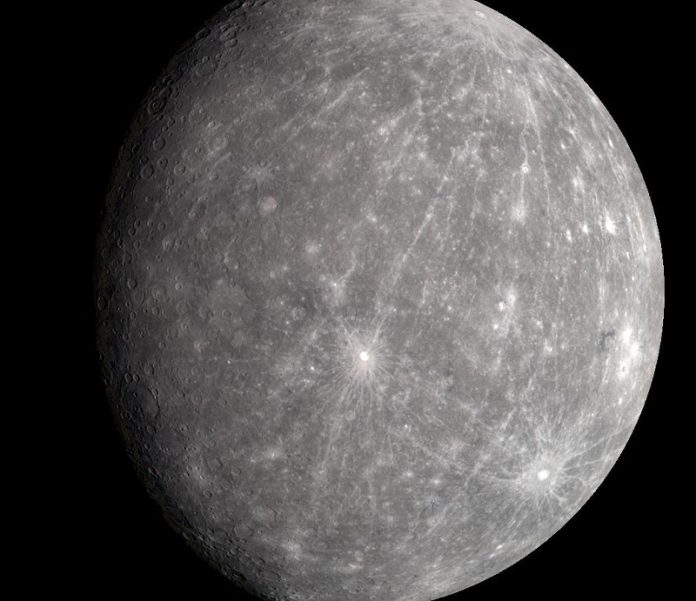
Mercury, the closest planet to our Sun, is also one of the least understood in the Solar System.
On the one hand, it is similar in composition to Earth and the other rocky planets, consisting of silicate minerals and metals differentiated between a silicate crust and mantle and an iron-nickel core.
But unlike the other rocky planets, Mercury’s core makes up a much larger part of its mass fraction.
Mercury also has a mysteriously persistent magnetic field that scientists still cannot explain. In this respect, Mercury is also one of the most interesting planets in the Solar System.
But according to new research, Mercury could be much more interesting than previously thought. Based on new simulations of Mercury’s early evolution, a team of Chinese and Belgian geoscientists found evidence that Mercury may have a layer of solid diamond beneath its crust.
According to their simulations, this layer is 15 km (9 mi) thick sandwiched between the core and the mantle hundreds of miles beneath the surface.
While this makes the diamonds inaccessible (for now, at least), these findings could have implications for theories about the formation and evolution of rocky planets.
The international team consisted of researchers from the Center for High-Pressure Science and Technology Advanced Research, the School of Earth Sciences and Resources at the China University of Geosciences, the Department of Earth and Environmental Sciences at KU Leuven, and the Department of Geology at the University of Liege.
The paper that describes their findings, “A diamond-bearing core-mantle boundary on Mercury,” recently appeared in Nature Communications.
The team was originally inspired by previous research by a team from MIT, NASA’s Goddard Space Flight Center, and several prominent universities.
This consisted of a reassessment of Mercury’s gravity field based on the radio tracking measurements taken by NASA’s MErcury Surface, Space ENvironment, GEochemistry, and Ranging (MESSENGER) mission, which allowed scientists to gain a better understanding of the potential structuring of Mercury’s interior.
This data led scientists to theorize that Mercury’s internal structure consisted of a metallic outer core layer, a liquid core layer, and a solid inner core.
While the composition of the core remains uncertain, it seemed likely that the core contained abundant iron, nickel, silicon, and possibly sulfur and carbon.
The MESSENGER data further led scientists to believe that the large dark patches observed on Mercury’s surface were largely made up of graphite that was likely turned up from the interior.
This data suggests that sufficient quantities of carbon could have crystallized in Mercury’s interior between the core and mantle boundary and floated up to the surface as graphite.
Given the amount of graphite on Mercury’s surface, it stands to reason that the planet was saturated with carbon. Previously, diamond (a mineral composed of pure carbon) was ruled out as a possible product because it was believed that the necessary pressures did not exist close to Mercury’s core.
However, if the boundary between the core and the mantle were deeper than previously thought, the necessary pressure conditions may have existed after all.
For their study, the team relied on thermodynamic modeling to recreate these pressure conditions based on the existence of a deeper core-mantle boundary. These experiments allowed them to simulate what conditions were like for Mercury as it slowly cooled.
Their results indicated that presuming a sulfur content of around 11% and a pressure of roughly 1-2% percent of that in Earth’s interior, diamond could crystalize within the molten core. They further found that this diamond would form a layer that could remain stable enough to rise along with graphite towards the mantle.
Over the course of eons, their experiments suggested that this diamond would form a layer around 15 to 18 km (~9 to 11 mi) thick. Considering how diamond is an exceptional thermal conductor, the presence of this layer could change the way astrogeologists model the interior dynamics of Mercury and shed light on its mysterious magnetic field.
The way heat rises from the core significantly affects the cooling and evolution of rocky planets, and the movement of materials in the interior is responsible for the generation of magnetic fields.
Not only is Mercury the only rocky planet other than Earth to have a magnetosphere, but there is evidence that it may be far older than our own.
As such, revised models of Mercury’s interior could explain how the planet’s magnetosphere has persisted for so long. Beyond Mercury, these findings could have significant implications for prevailing theories of how the rocky planets of our Solar System formed and evolved.
Written by Matt Williams/Universe Today.



